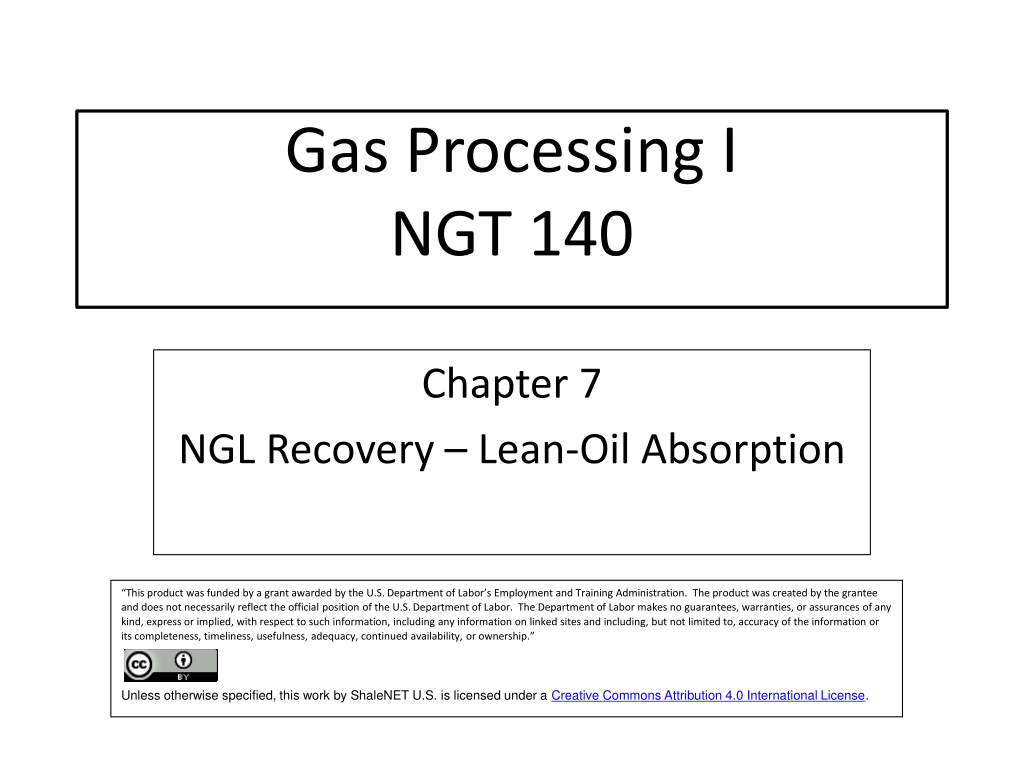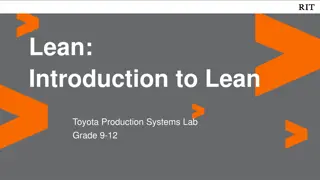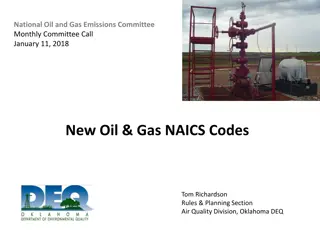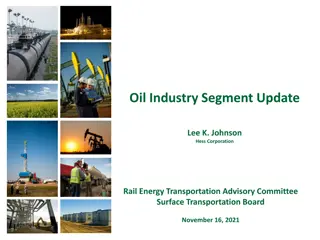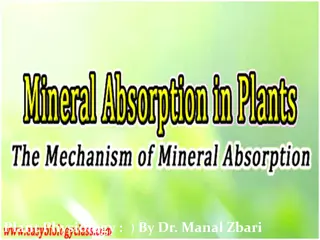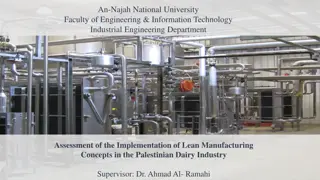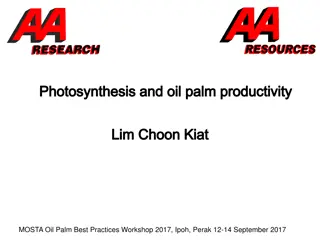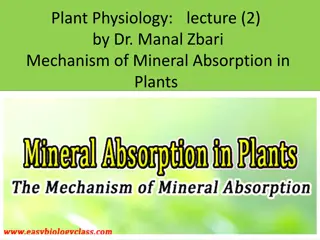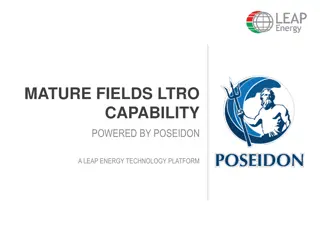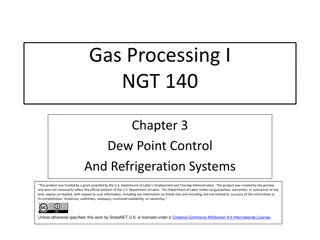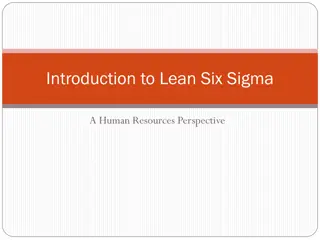Lean Oil Absorption Process in Gas Processing
The Lean Oil Absorption process in gas processing involves using hydrocarbon-rich lean oil to absorb heavier hydrocarbons from natural gas, allowing for increased gas condensate recovery. This method is a cost-effective way to separate different products in natural gas, alongside refrigeration processes. The process includes recovery, rejection, and separation stages, with the main equipment being the absorber. Chapter 7 details the traditional lean oil absorption process, while Chapter 8 explores newer refrigeration and turboexpansion methods.
Uploaded on Sep 11, 2024 | 1 Views
Download Presentation

Please find below an Image/Link to download the presentation.
The content on the website is provided AS IS for your information and personal use only. It may not be sold, licensed, or shared on other websites without obtaining consent from the author.If you encounter any issues during the download, it is possible that the publisher has removed the file from their server.
You are allowed to download the files provided on this website for personal or commercial use, subject to the condition that they are used lawfully. All files are the property of their respective owners.
The content on the website is provided AS IS for your information and personal use only. It may not be sold, licensed, or shared on other websites without obtaining consent from the author.
E N D
Presentation Transcript
Gas Processing I NGT 140 Chapter 7 NGL Recovery Lean-Oil Absorption This product was funded by a grant awarded by the U.S. Department of Labor s Employment and Training Administration. The product was created by the grantee and does not necessarily reflect the official position of the U.S. Department of Labor. The Department of Labor makes no guarantees, warranties, or assurances of any kind, express or implied, with respect to such information, including any information on linked sites and including, but not limited to, accuracy of the information or its completeness, timeliness, usefulness, adequacy, continued availability, or ownership. Creative Commons License Unless otherwise specified, this work by ShaleNET U.S. is licensed under a Creative Commons Attribution 4.0 International License.
Ch 3 Ch 5 Ch 2 Ch 7 & 8 Ch 10 Ch 4 Ch 6 Ch 9 Ch 2 Ch 9
Raw Natural Gas Hydrocarbons methane, ethane, propane and butane. Nonhydrocarbons nitrogen,helium, carbon dioxide. Kerosene was in demand and natural gas was burnt off. A form of gasoline become a by product which then became in demand Lean oil absorption process was developed to increase production.
Lean oil absorption Lean oil is a hydrocarbon liquid when in contact with natural gas absorbs heavier hydrocarbons. This allowed for more gas condensate to be recovered. Permitting more specific natural gas products to be produced. Lean oil absorption is only one way to separate various products in natural gas. A less expensive process is by refrigerating the gas to remove the propane and heavier hydrocarbons.
Chapter 7 presents the older, but still commonly used, lean oil absorption process. Chapter 8 covers the newer processes of refrigeration and turboexpansion.
Lean-Oil Absorption Primary Systems (Fig. 7.1) 1. Recovery 2. Rejection 3. Separation
Lean-Oil Absorption Primary Systems 1. Recovery All product to be recovered is removed from the inlet gas by a combination of refrigeration and absorption. The main piece of equipment is the absorber Remaining equipment is used to increase the efficiency of the absorber Absorption oil removes some of the components from the gas Absorption oil is called lean oil Absorption works by transferring hydrocarbon molecules from the gas phase to the liquid phase. The liquid phase is rich oil
Lean-Oil Absorption Primary Systems 1. Recovery (continued) The main piece of equipment in the recovery section is the absorber. Absorption is a process in which a liquid solvent removes some of the from a gas. Absorption oil is called lean oil that is it contains little of the desired hydrocarbons to be extracted from the gas. Absorption is the transfer of hydrocarbon molecules from the gas phase in the inlet gas to the liquid phase (or rich oil). A problem is that the lean oil vaporizes more easily in the residue gas.
Lean-Oil Absorption Primary Systems 1. Recovery (continued) Oil to gas ratio measures how hard the absorber is working. The ratio is expressed as gallons per minute of lean oil circulated per million cubic feet of gas through the absorber. In the recovery stage unwanted methane always remains and must be removed. Absorber a tower or column used to remove various products or emissions from a natural gas stream, which provides contact between the gas and the absorption oil
Lean-Oil Absorption Primary Systems 2. Rejection System
Lean-Oil Absorption Primary Systems 2. Rejection System Gets rid of the methane retained by the recovery system and cannot not be sold as a liquid product This is called demethanizing Methane is rejected in two steps 1. Hot rich-oil flash tank (p. 104) 2. Rich-oil demethanizer (ROD)(p. 105) 3. ROD tower top strips & bottom reasorbs. 4. Stripper the process of removing light components in the gas through vaporization.
Lean-Oil Absorption Primary Systems 3. Separation System
Lean-Oil Absorption Primary Systems 3. Separation System Fluid from ROD bottoms is fed to the separation system where the product is separated from the lean oil. Product goes out the top of the still and lean oil out the bottom This is called distillation Still a product condensing facility or vessel in which hydrocarbon distillation is done. Also called a rich-oil fractionator.
Lean-Oil Absorption Primary Systems Figure 7.3 Figure 7.8 Figure 7.12
